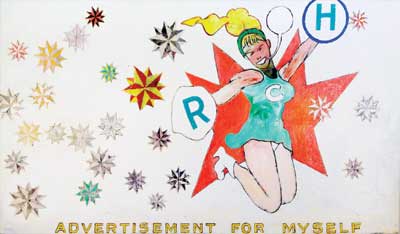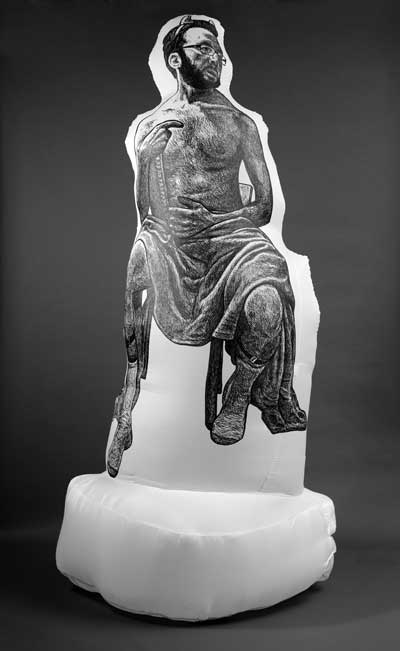Battle of the Sexes
by Jack Foran

Round four of the Amid/In WNY series continues at Hallwalls
A subtle and understated battle of the sexes seems to be going on in the current Hallwalls show. Basically about which side has it worse. I think the male side wins, at least in the Hallwalls skirmish in what is arguably a larger war that won’t get decided anytime soon. But I admit I am biased. I am on that side. But I am attracted to the argument Jason Seeley makes for the side because it is cogently argued and with a sense of humor in the artwork. Though I also admit I may not be getting some of the argument on the other side, because it is unavailable to me. Based on membership in the male group. As Dorothy Fitzgerald notes in her expository statement about her work, “I paint the feminine body because I find it a safe place for weaving a narrative of body image by women for women...I often have conversations about my body with myself and these talks end up in my paintings. Sometimes I make those conversations clear and sometimes I put them in secret code for women only.” Of course I miss all the secret code stuff.


One of Seeley’s paintings shows him—presumably him—splayed out as if on a rack medieval torture device, arms and legs stretched to improbable lengths. Accompanied by an expository diatribe on the “forces and contradictions” involved in trying to be the breadwinner in a divorced family situation, a court-ordered obligation independent and effectively “at the expense of the real paternal engagement necessary in the lives [of the children of the former union], which is seen as supplemental in the eyes of the legal system.” Another shows him looking the essence of forlorn naked while he describes the additional burden of trying to be an artist in the process. “An investigation of my own struggle as a white, male, father, artist, against an imposed idea of what my role should be as a real man and a real artist, and my own systems of self worth in both those arenas...”
Artist Liz Bayan has side-by-side videos of what seem to be two different takes of the same lugubriously slow couple embrace dance with minimal footwork—feet never leave the ground actually—accompanying her personal statement on the matter of personal relationships or really absence thereof. “Intimacy eludes me,” she says. “If ever there was a time when an intimate relationship with a man felt right, I can’t remember it. Instead, my romantic relationships have left me feeling deeply disconnected from myself, casting my identity as a heterosexual interloper.” Brava for honesty, anyway. The message of the videos is then enigmatic at best. There is embrace, but whether loving or strangling seems left open to viewer interpretation.
Liz Lessner has a series of sculptures in a rather Isamu Noguchi mode that she describes as “negative space castings of people engaged in intimate gestures.” Such gestures or actions as thigh to thigh contact in a crowded space, an airkiss, and calves meeting and touching under a table.
Fitzgerald’s feminine plight paintings feature fragmented female figures and assorted artist marks and possible domestic reference items—scraps of floral print wallpaper, some a barely legible bouquet of actual flowers, a dog, what could be an apple or tomato form pincushion—and various possible code.
Two paintings by Richard Huntington combine serious painterly issues and throwaway comic content, one more successfully, one less. One is entitled Advertisement for Myself, in takeoff reference to a similarly titled 1960s-era book by Norman Mailer. The painting shows a cheerleader in miniskirt costume in mid-leap of appreciation and admiration of the artist, “RH,” against a backdrop of ten-pointed stars to signal, the artist says in his statement, “the painter’s twinkling brilliance and cosmic importance.” He goes on to explain that “the challenge of the painting was to make a fairly flat and formally aggressive figure cohere with the relatively delicate construction of the stars that were only spatially anchored by the lumpy white ground.” Whatever. Coherence is not a problem. What is problematic is how even at explicit comic ironic remove, some of the narcissistic obnoxiosity of the Mailer project adheres to the parody piece. More successful is the piece entitled Good Work, Sally, a putative single frame from the vintage Dick Tracy comic strip, in a similar to the ground beneath the stars lumpy dense painterly mode throughout, and without any Mailerian taint.
More genuine advertisement for the artist without any Mailerian taint is the novel media three-dimensional work of Benjamin Entner. He sketch draws famous sculptural works—Michelangelo’s David, his Moses, the Hermes and the Infant Dionysius of some unknown Hellenistic age carver—but with the artist’s own face—again, presumably—on a large cloth bag of sorts inflated via attached fan apparatus. Clever and unusual. Nothing like it. Except those goofy tubular pneumatic figures that successively stand tall and flop and fold in the middle in front of mobile phone stores. Except that Entner’s don’t flop and fold.
This is round four of the Amid/In WNY series. It continues through October 23.
blog comments powered by Disqus|
Issue Navigation> Issue Index > v14n41 (Week of Thursday, October 15) > Battle of the Sexes This Week's Issue • Artvoice Daily • Artvoice TV • Events Calendar • Classifieds |









 Current Issue
Current Issue